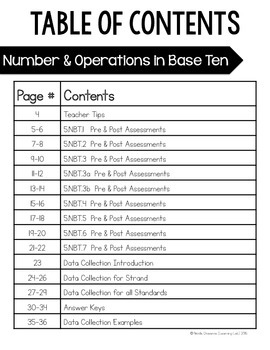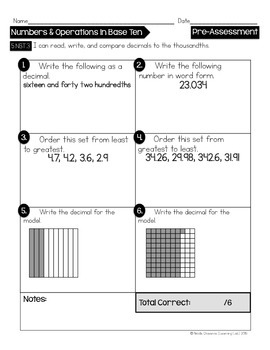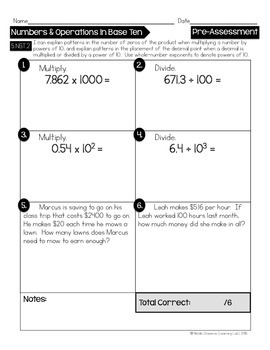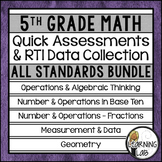Numbers & Operations - 5th Grade Quick Assessments and RTI Data Collection (NBT)
Learning Lab
7.7k Followers
Grade Levels
5th, Homeschool
Subjects
Resource Type
Standards
CCSS5.NBT.A.1
CCSS5.NBT.A.2
CCSS5.NBT.A.3
CCSS5.NBT.A.3a
CCSS5.NBT.A.3b
Formats Included
- PDF
Learning Lab
7.7k Followers
Also included in
- 5th Grade Math Standards This set covers all 40 of the 5th grade common core math standards. There is a pre-assessment and a post-assessment with a total of 12 questions each for each standard (480 total questions). Data collection sheets for RTI are included for individual strands, as well as fPrice $39.95Original Price $45.00Save $5.05
Description
Numbers and Operations in Base Ten
This set covers all 9 standards in the Numbers and Operations in Base Ten strand. There is a pre-assessment and a post-assessment with a total of 12 questions each for each standard. Data collection sheets for RTI are included for this strand, as well as for all 5th grade math standards.
The purpose of this product is to provide you with a quick and easy way to assess your students before and after they have been taught a standard.
The other strands will be added as new products when completed.
Check out the money-saving 5th Grade Math Quick Assessments and RTI Data Collection BUNDLE!
Do your students need editing practice to improve their writing? This freebie will give them an entire week of editing practice!
This set covers all 9 standards in the Numbers and Operations in Base Ten strand. There is a pre-assessment and a post-assessment with a total of 12 questions each for each standard. Data collection sheets for RTI are included for this strand, as well as for all 5th grade math standards.
The purpose of this product is to provide you with a quick and easy way to assess your students before and after they have been taught a standard.
The other strands will be added as new products when completed.
Check out the money-saving 5th Grade Math Quick Assessments and RTI Data Collection BUNDLE!
Do your students need editing practice to improve their writing? This freebie will give them an entire week of editing practice!
Total Pages
Answer Key
Included
Teaching Duration
N/A
Report this resource to TPT
Reported resources will be reviewed by our team. Report this resource to let us know if this resource violates TPT’s content guidelines.
Standards
to see state-specific standards (only available in the US).
CCSS5.NBT.A.1
Recognize that in a multi-digit number, a digit in one place represents 10 times as much as it represents in the place to its right and 1/10 of what it represents in the place to its left.
CCSS5.NBT.A.2
Explain patterns in the number of zeros of the product when multiplying a number by powers of 10, and explain patterns in the placement of the decimal point when a decimal is multiplied or divided by a power of 10. Use whole-number exponents to denote powers of 10.
CCSS5.NBT.A.3
Read, write, and compare decimals to thousandths.
CCSS5.NBT.A.3a
Read and write decimals to thousandths using base-ten numerals, number names, and expanded form, e.g., 347.392 = 3 × 100 + 4 × 10 + 7 × 1 + 3 × (1/10) + 9 × (1/100) + 2 × (1/1000).
CCSS5.NBT.A.3b
Compare two decimals to thousandths based on meanings of the digits in each place, using >, =, and < symbols to record the results of comparisons.






